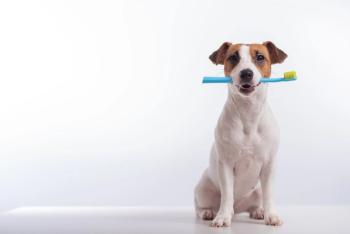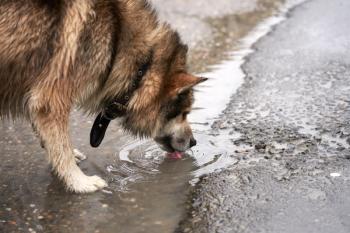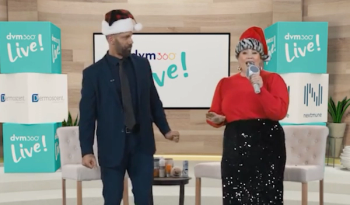
Skills Laboratory: Canine semen collection
This procedure is not only useful for breeding purposes but can also help you detect problems in a dog's prostate gland.
Semen collection is performed as part of breeding soundness examinations, cryopreservation, chilled semen shipping, and fresh artificial insemination. Semen collection is also an integral tool for the diagnosis of certain prostatic disorders. A manual collection technique is used in dogs.
Creative a conducive environment
It is best to perform semen collection in a quiet, nonstressful environment. Thus, a traditional veterinary examination room with its various smells, sights, and sounds may not be conducive to obtaining an adequate ejaculate. Also, it is important for the dog to maintain adequate footing during the collection process, so a nonslip rug or mat is helpful (Figure A).
Figure A
Use a teaser
The best ejaculate, in almost all cases, will be obtained with the use of a teaser bitch. Ideally, the bitch should be in estrus, although artificial swab scents can be used if the female is in anestrus. These scents are commercially available, or swabs can be obtained from a bitch in estrus and frozen for later use. An adequate number of technicians or assistants to control each participant is important.
The female should never be allowed to turn and bite or show aggression toward the male, especially if the female is in anestrus. Muzzle the bitch if necessary since aggression may lead to an inability to collect the male during this attempt and possibly during future attempts.
Have the right equipment
Semen is most often collected into a clean, nonsterile container. Commercially available collection sleeves, polypropylene disposable AI cones (JorVet), and Whirl-Pak bags (Nasco) are commonly used. It is important to have collection equipment ready and in hand before introducing the male to the female, as some males are eager to be collected.
The exposed tissue of the penis and bulbus glandis are sensitive and should be handled with care while you are using collection devices. Avoid rough edges and seams. Folding over the rough, leading edges of the collection sleeve, as shown in Figure B, often helps alleviate painful contact with the bulbus glandis. The collector should wear examination gloves during collection.
Figure B
How to collect canine semen
Step 1
Allow the male to approach the properly restrained female. Position the teaser with its hindquarters just in front of a rug or mat, which will provide adequate traction. It is best to position the teaser first, before bringing the male into the room (Figure 1).
Figure 1
Step 2
Bring in the male and allow it to approach the female. The male will usually begin to sniff and lick the female at this time (Figure 2).
Figure 2
Step 3
Provide moderate to vigorous stimulation to the penis through the prepuce until an erection begins. Slide the prepuce behind the bulbus glandis and apply pressure proximal to the bulbus glandis by encircling your fingers and thumb around the bulbus glandis as it enlarges while simultaneously sliding the first collection cone over the length of the penis (Figure 3).
Figure 3
Allowing the dog to obtain a full erection and ejaculate while its penis is in the prepuce can cause pain and discomfort. This discomfort is prevented by completely sliding the prepuce proximal to the bulbus glandis before a full erection is achieved. If a full erection and engorgement of the bulbus glandis are achieved within the prepuce, it is helpful to stop the collection process before the dog ejaculates, walk it around in another environment until the engorgement subsides, and then try the collection later.
Step 4
Once the dog begins to thrust, collect the ejaculate into the collection cones with different fractions of the ejaculate separated by quickly changing cones. Be sure to have three collection cones ready if each fraction is to be separated. If the dog obtains a full erection without thrusting, do not remove the first collection cone; the dog might still ejaculate normally.
- Fraction 1 is from the prostate and is small in volume (usually 1 to 3 ml) and mostly acellular.
- Fraction 2 is the sperm-rich fraction (usually 2 to 3 ml). It is thick and cloudy and contains sperm cells.
- Fraction 3 is prostatic in origin and has a large volume and usually low cellularity (depending on the condition of the prostate).
Fraction 1 and fraction 2 are sometimes difficult to separate, as they are often ejaculated during the thrusting portion of the collection and can occur somewhat close together. Fraction 3 is usually collected once the thrusting subsides, when the collector can feel pulsing of the penis. It is often not desirable or necessary to collect a large portion of fraction 3 of the ejaculate if the collection is for chilling or freezing semen. However, if you are evaluating for prostate disease, this fraction is useful, and a large volume in a separate collection cone is acceptable. The male will often attempt to step over, and the penis will be directed caudally. This is the point when the tie would occur during natural breeding (Figure 4).
Figure 4
<
Step 5
Once the desired amount of ejaculate is obtained, remove the collection cone, and observe the male until complete detumescence has occurred and its penis has completely returned to its normal position in the prepuce. Applying a moderate amount of lubrication to the bulbus glandis will help the penis return to its normal position.
Newsletter
From exam room tips to practice management insights, get trusted veterinary news delivered straight to your inbox—subscribe to dvm360.




